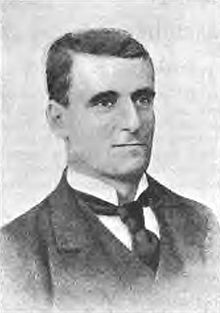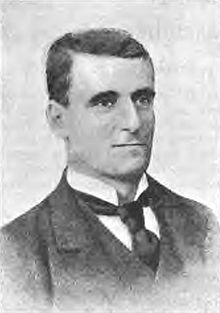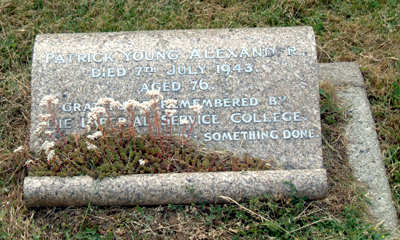Patrick Young Alexander
Alexander was born at Hern Villa, Belvedere, Erith, Kent. His mother was Harriotte Emma and his father was Andrew Alexander from Scotland.
He had an elder brother, John Edmond who was three years older.
886, while he was away from England, Patrick Alexander's elder brother died. The following year, Patrick's mother, Emma, died. In 1890, Patrick's father, Andrew, died at the age of 62. Now aged 23, Patrick was quite alone. Patrick's father had left him everything: almost £60,000 (equivalent to £6.06 million in A.D. 2018
A British aeronautical pioneer fascinated by the possibility of heavier-than-air flight. He was an enthusiastic balloonist and he was also particularly active in meteorology. He performed many metrological and aviation experiments, designing and building his own equipment. He travelled widely, visiting Australia in his youth and later making many visits to US crossing the Atlantic at least 50 times, he travelled widely in Europe and visited Mexico, Russia, Siberia and Africa in pursuit of his interests.
Patrick Alexander was respected by fellow aeronautical pioneers and knew Octave Chanute, the Wright brothers, Alberto Santos-Dumont, Lawrence Hargrave, Louis Blériot, Henry Farman, Ferdinand von Zeppelin, Charles Rolls of Rolls-Royce and Major Baden Baden-Powell, as well as European heads of state and royalty. Patrick, a world traveller, arranged meetings between those interested in aeronautics, and gave lectures on the progress being made.
Ever since the first balloon ascent by the Montgolfier Brothers in 1783, it had been realised that for balloons to be really useful, they had to be navigable. Patrick Alexander applied his mind to this problem of airship propulsion. In 1893 and 1894 he filed a number of patents. His ideas included reciprocating oars and an adjustable-pitch propeller that resembled a pair of fans. One patent includes a means of heating the gas in the balloon envelope by using piped steam, the steam pipe also served to support the balloon in the shape of a parachute in the event of the balloon being burst or punctured.
On hearing that Patrick Alexander was planning a return trip to the US in October 1903, the Wright brothers, not known for welcoming interruptions to their work, said they would be happy to meet him. However, Patrick missed a crucial telegram and never received their message(kinda like eMail now). Patrick must have been most disappointed to have missed the opportunity to witness the first flights of the Wright Flyer on December 17th, 1903.
Aldershot was an insignificant village until, in 1854, it was selected as the home of the British Army. It was in Aldershot that the army established the Army Balloon section - later to evolve into the Corps of Royal Engineers. In June 1904 the American born aviation pioneer Samuel Franklin Cody came to Aldershot to test his kites. There, in collaboration with the Army, he worked on balloons, kites and aeroplanes. That same year Patrick Alexander moved to nearby Mytchett in Surrey where he was involved with the Army Balloon section. He shared a house with Cody who later went on to become the first man in England to fly an aeroplane.
January 1910, Patrick Alexander issued the conditions of a £1,000 Alexander Award, a prize that he would offer for the development of a lightweight engine suitable for aviation. The prize was offered through the auspices of the Aerial League of which Alexander was a founding member and the testing would be performed by the National Physical Laboratory.
(The prize, which was Alexander's own money, was a considerable sum; £1,000 in 1910 is equivalent to £86,000 in 2014.) Tests were carried out one year later. The Green Engine by Aster Engineering Ltd performed particularly well and, by unanimous agreement, won the prize.
At the end of the First World War, Patrick Alexander was fifty years old and his inheritance was all but gone. Even his prodigious energies had been unable to keep up with the developments in aviation that had taken place during the conflict. He spent the rest of his life at the Imperial Service College, Windsor. There he taught students the basics of aeronautical principles.
Patrick Alexander died on July 7th, 1943, almost penniless having given most of his money away.
Patrick Alexander was buried in a small churchyard in Windsor. Ironically his headstone faces the flight path from Heathrow Airport, and features a simple inscription:
"Something Attempted Something done"
....
...
..
.
Bio;
By
Jonathan Robert De Mallie, Historian
Patrick Young Alexander
Alexander was born at Hern Villa, Belvedere, Erith, Kent. His mother was Harriotte Emma and his father was Andrew Alexander from Scotland.
He had an elder brother, John Edmond who was three years older.
886, while he was away from England, Patrick Alexander's elder brother died. The following year, Patrick's mother, Emma, died. In 1890, Patrick's father, Andrew, died at the age of 62. Now aged 23, Patrick was quite alone. Patrick's father had left him everything: almost £60,000 (equivalent to £6.06 million in A.D. 2018
A British aeronautical pioneer fascinated by the possibility of heavier-than-air flight. He was an enthusiastic balloonist and he was also particularly active in meteorology. He performed many metrological and aviation experiments, designing and building his own equipment. He travelled widely, visiting Australia in his youth and later making many visits to US crossing the Atlantic at least 50 times, he travelled widely in Europe and visited Mexico, Russia, Siberia and Africa in pursuit of his interests.
Patrick Alexander was respected by fellow aeronautical pioneers and knew Octave Chanute, the Wright brothers, Alberto Santos-Dumont, Lawrence Hargrave, Louis Blériot, Henry Farman, Ferdinand von Zeppelin, Charles Rolls of Rolls-Royce and Major Baden Baden-Powell, as well as European heads of state and royalty. Patrick, a world traveller, arranged meetings between those interested in aeronautics, and gave lectures on the progress being made.
Ever since the first balloon ascent by the Montgolfier Brothers in 1783, it had been realised that for balloons to be really useful, they had to be navigable. Patrick Alexander applied his mind to this problem of airship propulsion. In 1893 and 1894 he filed a number of patents. His ideas included reciprocating oars and an adjustable-pitch propeller that resembled a pair of fans. One patent includes a means of heating the gas in the balloon envelope by using piped steam, the steam pipe also served to support the balloon in the shape of a parachute in the event of the balloon being burst or punctured.
On hearing that Patrick Alexander was planning a return trip to the US in October 1903, the Wright brothers, not known for welcoming interruptions to their work, said they would be happy to meet him. However, Patrick missed a crucial telegram and never received their message(kinda like eMail now). Patrick must have been most disappointed to have missed the opportunity to witness the first flights of the Wright Flyer on December 17th, 1903.
Aldershot was an insignificant village until, in 1854, it was selected as the home of the British Army. It was in Aldershot that the army established the Army Balloon section - later to evolve into the Corps of Royal Engineers. In June 1904 the American born aviation pioneer Samuel Franklin Cody came to Aldershot to test his kites. There, in collaboration with the Army, he worked on balloons, kites and aeroplanes. That same year Patrick Alexander moved to nearby Mytchett in Surrey where he was involved with the Army Balloon section. He shared a house with Cody who later went on to become the first man in England to fly an aeroplane.
January 1910, Patrick Alexander issued the conditions of a £1,000 Alexander Award, a prize that he would offer for the development of a lightweight engine suitable for aviation. The prize was offered through the auspices of the Aerial League of which Alexander was a founding member and the testing would be performed by the National Physical Laboratory.
(The prize, which was Alexander's own money, was a considerable sum; £1,000 in 1910 is equivalent to £86,000 in 2014.) Tests were carried out one year later. The Green Engine by Aster Engineering Ltd performed particularly well and, by unanimous agreement, won the prize.
At the end of the First World War, Patrick Alexander was fifty years old and his inheritance was all but gone. Even his prodigious energies had been unable to keep up with the developments in aviation that had taken place during the conflict. He spent the rest of his life at the Imperial Service College, Windsor. There he taught students the basics of aeronautical principles.
Patrick Alexander died on July 7th, 1943, almost penniless having given most of his money away.
Patrick Alexander was buried in a small churchyard in Windsor. Ironically his headstone faces the flight path from Heathrow Airport, and features a simple inscription:
"Something Attempted Something done"
....
...
..
.
Bio;
By
Jonathan Robert De Mallie, Historian
Sponsored by Ancestry
Advertisement
Explore more
Sponsored by Ancestry
Advertisement




